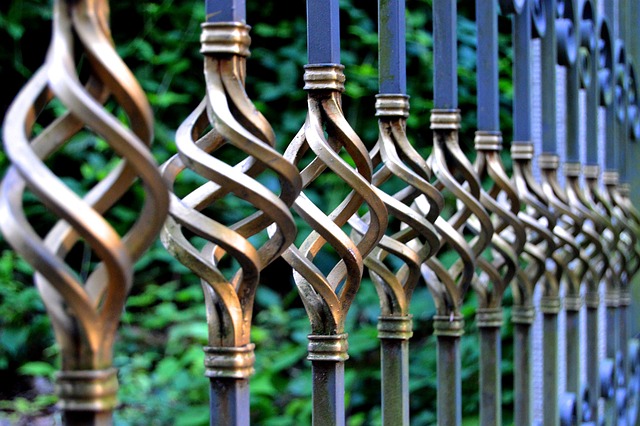Metal fabrication is an advanced field involving the transformation of raw metal into complex structures through precise processes like laser cutting and welding, adhering to engineering specifications. The choice of metal alloy, such as steel for strength or aluminum for corrosion resistance, is critical based on the structure's intended use and environmental conditions. Quality assurance at every stage, from cutting to assembly, ensures the final product's reliability and safety. In harsh environments, materials like stainless steel, aluminum alloys, or galvanized steel are preferred due to their enhanced durability. Innovations in Additive Manufacturing, CAD, and CNC machining have revolutionized metal fabrication, enabling complex designs with reduced waste and improved strength-to-weight ratios. The integration of AI into the manufacturing process enhances efficiency and cost savings while promoting sustainability. Compliance with safety standards such as OSHA and EN 1090 is mandatory to ensure platforms can handle heavy loads under various conditions without compromising safety. Advanced engineering practices combined with non-destructive testing techniques are essential for maintaining structural integrity and reliability across multiple industries, underscoring the importance of a robust safety framework in metal fabrication.
Exploring the intricate world of metal fabrication, this article delves into the crafting of robust platforms, frames, and supports. We’ll traverse the essential steps in the metal fabrication process, scrutinize material choices that bolster structural integrity, and investigate how cutting-edge technologies are reshaping the industry. Additionally, we’ll address the critical aspects of compliance and safety standards to ensure the longevity and reliability of these metal constructions. Join us as we dissect the pivotal role of metal fabrication in various sectors, emphasizing its indispensable nature in maintaining infrastructure resilience.
- Understanding the Metal Fabrication Process for Platforms, Frames, and Supports
- Material Considerations: Selecting the Right Metals for Structural Integrity
- The Role of Advanced Technologies in Modern Metal Fabrication
- Ensuring Compliance and Safety Standards in Metal Platform Construction
Understanding the Metal Fabrication Process for Platforms, Frames, and Supports

Metal fabrication is a complex process that involves transforming raw metal into intricate structures, such as platforms, frames, and supports, tailored to meet specific requirements for strength, durability, and functionality. Skilled professionals use precision tools and advanced techniques like laser cutting, welding, and forming to shape the metal into its intended form. These processes are guided by detailed designs and engineering calculations to ensure that the final product can withstand the stresses of its operational environment.
The journey from raw material to a finished metal platform begins with selecting the appropriate type of metal based on the application’s demands, such as steel for heavy-duty use or aluminum for lighter applications where corrosion resistance is key. The chosen metal is then cut into the necessary components using high-precision equipment. Subsequently, these parts undergo a series of joining processes like welding and bolting to construct the framework. Throughout this process, quality control measures are implemented at each stage to maintain the integrity and safety of the final product.
Material Considerations: Selecting the Right Metals for Structural Integrity

When constructing metal platforms, frames, and supports, the choice of material plays a pivotal role in ensuring structural integrity and longevity. The selection process must account for factors such as the intended load-bearing capacity, environmental conditions, and the corrosion resistance properties of the metals. For instance, carbon steels are commonly used due to their high strength-to-weight ratio and workability. However, in environments prone to corrosion from salts, acids, or humidity, stainless steel or alloys like aluminum and galvanized steel may be more suitable due to their superior resistance to rust and degradation. Additionally, considering the fatigue strength and ease of maintenance is crucial when selecting materials for these critical components, as it directly affects the safety and functionality of the entire structure. The metal chosen must not only withstand the forces it will bear but also remain reliable over time under various conditions. This meticulous material selection process is a cornerstone of robust and enduring metal fabrications.
In the realm of metal fabrication, understanding the mechanical properties of different metals is essential for designing platforms that are both safe and efficient. Metals such as cold-rolled steel offer excellent formability and weldability, which are critical for complex frame designs. On the other hand, hot-rolled steel provides greater strength but may require additional finishing processes to achieve the desired dimensions and surface quality. The selection of metal alloys, including copper alloys or titanium, can offer a combination of high strength, low weight, and excellent corrosion resistance, making them ideal for applications in extreme environments. It is through this informed material selection that manufacturers can craft platforms capable of withstanding the test of time and use.
The Role of Advanced Technologies in Modern Metal Fabrication

3D printing technology has revolutionized the fabrication of metal platforms, frames, and supports by enabling the creation of complex geometries with high precision and minimal material waste. This process, also known as Additive Manufacturing, allows for the design optimization of structures, enhancing their strength-to-weight ratio and overall performance. The integration of artificial intelligence (AI) in metal fabrication further streamlines production by optimizing design processes and predictive maintenance, leading to more efficient and cost-effective manufacturing. These advancements not only accelerate the production timeline but also contribute to the sustainability of metal manufacturing practices.
Computer-aided design (CAD) software combined with computer numerical control (CNC) machining has significantly improved the precision and speed of cutting, milling, and drilling operations in the fabrication process. The synergy between advanced CAM algorithms and real-time machine feedback allows for intricate designs to be produced with a high degree of accuracy, reducing the need for manual adjustments and rework. Laser scanning technology also plays a pivotal role in quality control by providing rapid, non-destructive testing to ensure that the final metal products meet stringent industry standards. The adoption of these technologies ensures that metal platforms, frames, and supports are not only robust but also engineered to exceed functional expectations.
Ensuring Compliance and Safety Standards in Metal Platform Construction

In the construction of metal platforms, adherence to compliance and safety standards is paramount. The use of high-strength alloys and rigorous structural testing ensures that these platforms can withstand various environmental conditions and heavy loads, thereby maintaining integrity and safety under all operational scenarios. Compliance with international safety regulations, such as those set forth by the Occupational Safety and Health Administration (OSHA) or the European Standard EN 1090, is essential for the construction of metal platforms to guarantee they meet the necessary requirements for load-bearing capacities and prevent accidents.
Furthermore, the integration of advanced engineering techniques and the application of non-destructive testing methods play a crucial role in verifying the structural integrity of the platforms. These measures help identify any potential weaknesses or defects before they can pose a risk, ensuring that the final product is both compliant with safety standards and reliable for its intended use in various industries, including construction, manufacturing, and energy sectors. The commitment to maintaining these stringent quality control processes throughout the fabrication of metal platforms underscores the importance of safety in all stages of design, construction, and maintenance.
In conclusion, the fabrication of robust and safe metal platforms, frames, and supports represents a critical intersection of craftsmanship and innovation. The selection of appropriate materials and the application of advanced technologies are paramount in achieving superior structural integrity and adhering to stringent safety standards. As detailed throughout this article, understanding the intricacies of the metal fabrication process is essential for ensuring the longevity and reliability of these critical structures. By leveraging cutting-edge techniques and maintaining a commitment to compliance, the industry can deliver metal solutions that meet the diverse needs of various sectors, from construction to manufacturing. It is through continuous advancement and adherence to best practices that the integrity and safety of these metal constructs will endure, solidifying their role in the built environment.
